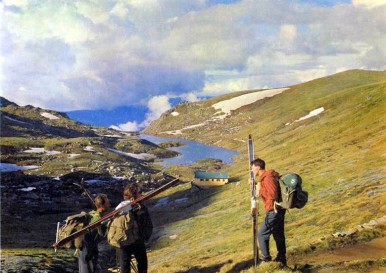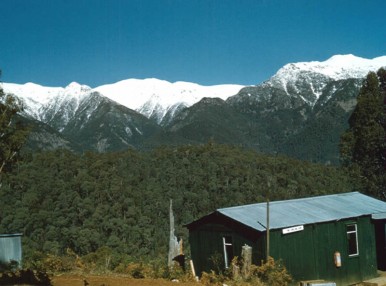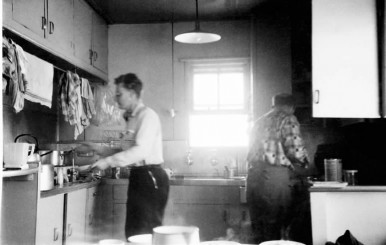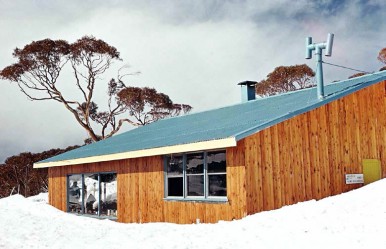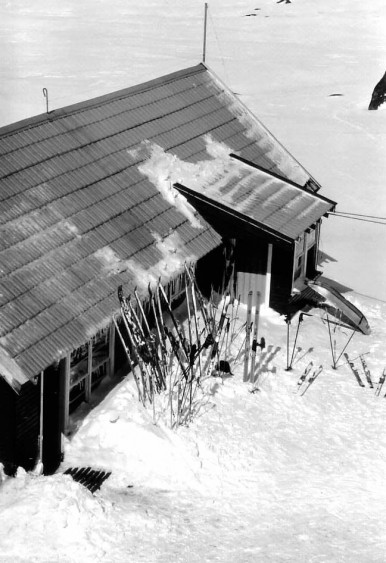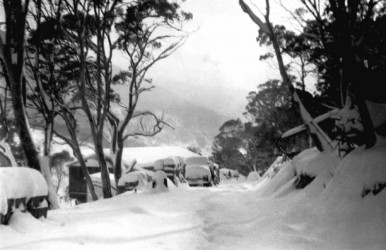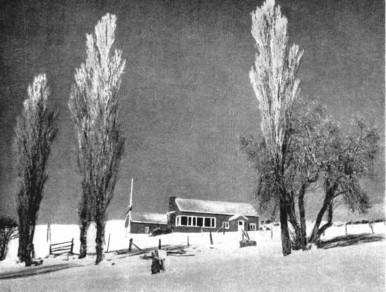Article Index
|
This sixth installment of the AAC's ski heritage photos takes you back to the decade 1950 to 1960 during which unprecedented expansion of skiing facilities occurred in the Snowy Mountains. This sixth installment also looks at the origin of the sudden increase in the numbers of skiers utilizing the Snowy Mountains in this decade, not only for ski exploration but also for downhill skiing using ski tows to return them to the top of the ski slope. At the start of the decade there were 2 ski tows in the Snowy Mountains. By 1960 there were ten. The main on-snow accommodation in 1950 was at the Hotel Kosciusko, the Chalet Charlottes Pass and Kiandra. The existing club accommodation in 1950 was best described as embryonic. In the next ten years four new NSW ski resorts – Perisher, Thredbo, Guthega and Smiggin Holes were founded. |
|
Writing in the March 1951 issue of SCHUSS, the magazine of the Ski Club of Victoria (SCV), Mr E. Axford wrote that the only club huts on Kosciusko in 1951 would be the Kosciusko Snow Revellers' Club 20 bed lodge in the Perisher Range, then under construction, the existing Ski Club of Australia at Charlotte's Pass (an annex to The Chalet), the Ski Tourers' Association (STA) 16 bed lodge at Lake Albina, then under construction at Lake Albina and the Kosciusko Alpine Club's new 22 bed lodge to be built at Charlotte's Pass. In addition to the three lodges on Kosciusko, the Kiandra Ski Club (founded about 1878 as the Kiandra Snow Shoe Club) probably had a lodge at Kiandra, although some of the members lived locally and visiting members had a couple of alternate accommodation options, including the then newly opened Kiandra Chalet. The first installment of this Australian ski heritage story contained photos of the construction of the Lake Albina Lodge, but did not explain how permission had been obtained to build it in a prime position overlooking the lake. The story, as told by ski identity Bob Arnott, was published in the December 1950 issue of "Ski Horizon", whilst Don Richardson wrote his account in the "1951 Australian Ski Year Book" printed in May 1951. They wrote how keen skiers had sought a hut close to the western faces of Kosciuszko for a number of years and how the Ski Council of NSW had advocated the building of a Memorial Hut in the vicinity some years earlier, whilst its Safety Sub-committee had, in May 1950, urged the Kosciuszko State Park Trust to provide such a hut for its safety values. The Ski Tourers Association was formed at a well-attended meeting held on 10th November 1950. Charles Anton was elected President, Margaret Anton was elected Secretary, and Robert Ward was elected Treasurer. Ken Breakspear and Dudley Ward were the elected Vice-Presidents. The STA Committee consisted of an enthusiastic group of Kosciusko main range skiers drawn from eight different NSW clubs and the STA membership included a significant Victorian contingent. |
| On 17 October 1949 work officially commenced on the Snowy Scheme, which had a major impact on NSW Ski Fields. A total of sixteen hundred kilometers of roads and tracks were constructed in 25 years, including the Alpine Way which provided the first vehicle access to the Thredbo Valley. The work required over 100 camps and work sites. Three camps – Guthega, Smiggin Holes and Cabramurra – became ski townships when they were no longer needed for construction purposes. Some camps had magnificent mountain vistas, such as the Seven Mile Drilling Camp (Photo 3). But not only did the Snowy Scheme open up the mountains, it also provided many keen skiers who had learnt to ski in their European homelands prior to migrating to Australia to work on the Snowy Scheme. |
| Construction of the Kiewa Hydro Scheme by Victoria's SECV on the Bogong High Plains and the lower slopes of Mt. Bogong itself, had commenced in the late 1930's, but was interrupted by the Second World War. Work recommenced in the late 1940's and the SECV construction workforce also included many migrant workers who were also keen skiers. The SECV access roads allowed the development of the Falls Creek ski village in the early post-war years. In 1948 two lodges (Bogong and Skyline) had been built and the Albury Ski Club had commenced building its lodge. By 1953 there were ten ski club lodges in Falls Creek, a public accommodation chalet and a ski school with a rope tow. |
| Australian soldiers occupying Syria in the second half of 1941 set up the 1st Australian Ski Corps School, in a ski resort at an altitude of 1900m in the Lebanon Mountains, to train hundreds of. Australian soldiers at a time, to ski and to become ski troops. This was in response to a possible thrust south through the Syrian mountain passes by the German Armies that had conquered Greece and invaded the Soviet Union. The instructors included Lindsay Salmon (Mt. Hotham) and Johnny Abbotsmith (Hotel Kosciuszko). The School had about 100 staff members and trained about two thousand Australians to ski and to fight in the snow whilst on skis (Photo Nos. 4 & 5). German forces did not reach Syria during the war, but the numbers of keen skiers back in Australia following the end of that war in 1945 was greatly increased, not only with the return of the Australian ski troops, but also by the large numbers of refugees who were skiers and who had migrated to Australia from European countries where skiing was well-established. |
| Charles Anton, the founding President of the Ski Tourers Association (STA), was one of many to be attracted to the Main Range by Elyne Mitchell's book "Australia's Alps". He wrote an account of these ski developments in the September 1961 issue of the Ski Australia magazine. The following paragraphs are based on that article. After describing the formation of the STA, Charles Anton wrote about the building of the Lake Albina Lodge (see the First Installment of AAC Ski Heritage for photos of its construction). In spite of great access and other difficulties, compounded by the onset of winter in mid-April, Lake Albina Lodge was able to operate in the 1951 winter. At 1990m altitude the lodge was the highest habitation in Australia. |
| During Winter 1951 many parties toured from the Lodge which slept 12 persons in six 2-bunk rooms. They were able to access the steep western faces of the Kosciusko Main Range with challenging slopes for ski mountaineers as well as the ideal ski touring terrain along the ridge-tops. |
| The more sheltered Mount Clarke-Northcote-Lee-Carruthers Basin, then known as the Kunama Basin, was developed for downhill skiing by building the Northcote Tow, opened in 1954 and Kunama Huette which opened in 1953. Like Albina, Kunama was equipped with all modern comforts such as electric light, running hot and cold water, flush toilets and gas cooking. |
| The Kunama Basin was the goal of many visitors from the Chalet Charlottes Pass and on fine days up to 100 residents and day visitors used the tow. Accommodation for four had been provided in the Northcote Tow House, which was also used by day visitors as a warming hut. The ambience of this beautiful basin during the 1954 and 1955 ski seasons was magic. There were joyous shouts of the skiers on the tow slopes, the clanking of nutcrackers over pulleys, the noise from the old tow engine and the Kunama generating plant. And then disaster. On the early morning of July 12, 1956, an avalanche from Mt. Clarke destroyed Kunama Huette and killed young Roslyn Wesche. The other huette occupants had lucky escapes from serious injury that morning. |
| Three weeks later the Northcote Tow House was burnt to the ground and rebuilding on the Main Range was impossible under the then recently amended Park Trust Regulations. Thus the fruits of three years of hard work were wiped out in three weeks. Main Range skiers were left with Lake Albina Lodge on the Main Range crest near Mt. Townsend and Illawong Lodge (Photo No. 9) nestling beside the Snowy River at the foot of Mt. Twynam. Although 16 club lodges were under construction in the Victorian Alps in 1950 and none were built in the Kosciuszko Ski Fields until 1951, the early 1950's did see a gradual expansion in the available NSW ski accommodation with the development of villages in the snow at Perisher and Guthega. In 1955 Charles Anton and three other members of the Ski Tourers Association formed the syndicate which planned the Thredbo Ski Resort on the planned Alpine Way Access Track across the alps from Jindabyne to Khancoban. |
| The first power station planned for the Snowy Mountains Scheme had a dam at the junction of the Guthega and Snowy Rivers diverting water into a tunnel through to the valley of White's River and surface penstock pipelines down to an above-ground power station at its junction with the Snowy River. The main construction village was built overlooking the dam site using mainly pre-fabricated huts imported from Norway for Selmer, the Norwegian contractors building the Guthega Project. Selmer flew in a total of 350 Norwegian workers between October 1951 and February 1952. The workforce was keen on skiing and ski jumping as recreational persuits and quickly established the Selmer Norwegian Ski Club, the large Guthega Jumping Hill (that allowed ski jumps of about 50 metres) and a rope tow for skiers. Guthega hosted many Nordic events in the 1950's. |
| Dam construction commenced in December 1951 and was completed in April 1955. Skiing continued at Guthega after most of the workers had moved on to other sites. In 1955 three of the cottages vacated by the departing workers were offered for lease to "bona-fide Ski Clubs". They were leased by Canberra YMCA Ski Club, SMA Ski Club of Cooma and Sydney University Ski Club . Surplus huts were sold, with some remaining in Guthega to form the nucleus of the ski village, whilst others were transported to various sites around the Snowy including Thredbo. Two new lodge buildings, for the Canberra YMCA Ski Club and the Blue Cow Ski Club, were completed prior to the 1960 winter. Construction commenced on Guthega Ski Club's lodge in 1962. Guthega continued to host Nordic and Downhill ski races. In 1961, for example, Guthega hosted the ACT Nordic Championships in July and the Balmain Cup slalom races in August. A rope tow was established by the SMA Ski Club in June 1958 on the Tate East Ridge above the Guthega River, where excellent powder snow could often occur in winter and early spring. Prior to the 1960 ski season, it was doubled in length to 430m with a vertical rise of 150m. It was extended again in 1963. This tow continued to operate until the late 1960's, when its location was designated as a wilderness area and the tow was removed. |
| The Perisher Hut on the Summit Road had long been used as a staging point for skiers and the over-snow transport travelling between the Hotel Kosciusko and both Betts Camp and the Chalet Charlottes Pass. The hut had also been used as overnight accommodation by skiers exploring the Perisher Range and who recognized the area's significant ski potential. Moves by skiers to gain permission from the Kosciusko Park Trust to build huts in the Perisher Valley had commenced in 1949. The Kosciusko Snow Revellers Club (KSR) gained approval in early 1950 for the erection of a 20 bed ski lodge in Perisher. The Telemark Club soon followed with its own building application. |
| The first club hut in Perisher was erected by KSR members over the Christmas Weekend in 1950, with water supply and septic tank being connected prior to the 1951 ski season. The club had earlier discovered that there was no local labour available for lodge building, due to the major works then in progress for the Snowy Mountains Hydro Scheme, and that some form of site accommodation was essential for working parties, if the building was to be erected by club members. KSR asked the Trust for permission to erect a temporary hut on the site to accommodate the volunteer workers, with this hut being incorporated in the permanent lodge as the work progressed. The Trust approved this request in September 1950. Construction was sufficiently advanced to provide KSR members with "Spartan" accommodation during the 1951 ski season. |
| This set the pattern followed for many of the club lodges erected in the 1950's – construction by volunteer labour over two or more years. A major effort was made to get each lodge to the "lock-up stage" before the on-coming winter closed down work on the exterior of the building. This gave a weather-proof shell within which the "fitting-out" could proceed irrespective of weather, but with hygienic but primitive conditions for occupants in the first couple of ski seasons whilst the volunteers finished the lodge. A good standard of workmanship was needed, as powder snow and rain could penetrate any tiny cracks and chinks in the outer fabric, whilst lodges could be partly buried by snow during winter, as shown in Photo No. 10. |
| Perisher lodge development generally was very slow at first, but accelerated after the complete destruction of the Hotel Kosciusko by fire on 18 April 1951. The many conflicting demands on the budget of the New South Wales State Government prevented the government from replacing the hotel. The Telemark Lodge operated in the 1952 Ski Season and others soon followed, with Cooma Ski Club, CSIRO and University Alpine Club lodges accommodating members in the 1953 Ski Season. The completed KSR lodge and the Orana Ski Club operated for the first time in the 1954 winter. Perisher Ski Tow and the club lodges of Warrugang, Sydney and Kandahar Clubs operated for the first time in the 1955 ski season. Built by the members themselves, the lodges had basic dormitory accommodation. For example, the Warrugang Lodge (Photo No. 11) had its ski room, boiler room and entry downstairs. The main floor had a large living room with open fireplace, plus a kitchen and two dormitories each with hot showers and toilets. Opened in May 1963, Perisher Huette was the first club lodge in Perisher Valley to have private en-suite facilities in all its bedrooms. |
| Ski lodge construction continued steadily each summer in the Perisher Valley with commercial guest lodges being built in addition to club lodges. The Sundeck Hotel was ready for the 1959 ski season and the Man from Snowy River Hotel opened in the winter of 1960. Photo Nos. 13 and 14 were taken in January 1963 and show that many of the buildings at Perisher were partly or completely screened from view by trees. The Sundeck Hotel is the light-brown building in the centre of Photo No.14. Winter skiing in Perisher Valley in 1955 was not for the faint-hearted. Most skiers had to ski in from the end of the snow-cleared road at the burnt-out Hotel Kosciusko, with a heavy rucksack containing their clothes and fresh food. If their club did not have tinned food stored in the lodge for use in the ski season, then the rucksack would be particularly heavy. The nearest food shop and the nearest hotel were at Jindabyne, one day's travel from Perisher. |
| In the 1950s, Perisher skiers often applied a small amount of Klister Ski Wax to the sole of each ski under the binding, so as to allow the ski to grip the snow when the skier was climbing to reach the top of a ski slope. Once at the top, the skis would be rubbed back and forward on the snow a couple of times to warm the wax (due to friction) and so allow the skis to run downhill across the snow. Once the skis stopped sliding, the wax would quickly cool and grip once more, to allow the next slope to be climbed. Uphill ski transport at Perisher in 1955 was provided by two rope tows. The first was a small portable ski tow (about 80m long) operated near KSR Lodge by Ski Instructor Johnny Abbotsmith, who lived in a ski tow hut overlooking the Kosciusko Summit Road, south-west of Smiggin Holes, where he had a more powerful rope ski tow about 150 metres in length. The second tow was located in North Perisher and was about 400 metres in length. |
| Skiers rode these rope tows by either hanging onto the rope with their hands (which quickly wore out their ski gloves) or using a device shaped like a nut-cracker that was attached by a short length of cord to a belt worn by the skier. Once the skier was moving, the nut-cracker was simply held closed by hand and the pulling force of the rope was applied to the skier via the cord and the belt. The rope moved only a little faster than walking speed so that there was little chance of injury if a skier lost grip of the rope and slid back down the tow track into other skiers. There could also be problems at the top of the tow if there was only a small unloading area onto which the arriving skiers could slide whilst they disengaged from the moving rope and got out of the way of the skiers following on behind (Photo No.15). The Perisher Tow Hut also provided refreshments and accommodation for its patrons. The Cooma Ski Club Lodge, then located where the mid-station buildings of the Back Perisher Triple Chair are now situated, first operated a 300m long rope tow in the 1958 ski season. The first T-bar ski tow was built in Perisher in 1959 for the Sundeck Hotel development. |
| Whilst ski resorts with ski tows were growing in south-eastern NSW, a sharp reduction occurred in the early 1950's to the numbers of skiers making cross-country skiing trips into the Mt. Jagungal wilderness area from the Alpine Hut (which was described in our Second Installment). The Alpine Hut had made a financial loss in 1952, when only 44 person-weeks were booked out of the maximum possible 160 person-weeks available for the 1952 winter. It is likely that the easier access to Perisher, Charlotte's Pass and to the recently constructed/renovated Lake Albina and Illawong Lodges, attracted some of the ski tourers that might have otherwise stayed at Alpine Hut. |
|
It was frequently possible, during the 1950's, 1960's and even into the early 1970's, to ski to Mt. Jagungal from any of Mawson's, Grey Mare, Derscherko's and Pretty Plain huts, without meeting another skier during the journey. Paul Reader, Douglass Baglin and Keith Field documented, in the 1955 Ski Year Book, their July 1954 Kiandra to Kosciusko (Guthega) trip of 7 days duration, on downhill skis with touring bindings, during which no other human was seen until their destination was reached. The adoption of lightweight Nordic ski gear by cross-country skiers in the 1970's, facilitated the making of long ski trips into wilderness areas, such as Mt. Jagungal and attracted many new recruits to ski touring. |
| The skiing potential of the slopes overlooking the Crackenback River Valley (also known as the Thredbo River) was known ever since the Charles Kerry party had climbed from the Crackenback River to the summit of Mt. Kosciuszko in 1897. Following ski expeditions with Chalet Manager George Day and others, to the area in 1937 and 1942, Elyne Mitchell had written:- "The valley of the Crackenback, below Dead Horse [Gap], is one of the few places in our hills where a small alpine village would not be incongruous. The slopes off the Ram's Head Range are like many of the ski runs above the smaller European villages; there are plenty of ridges and valleys descending from the main peaks and it is well tucked away from the wind – the curse of Australian skiing. Here there is a feeling of peace rather than the constant sense of the wilderness." (Australia's Alps, ANGUS AND ROBERTSON 1942, p124). |
|
No doubt numerous other skiers from the Chalet heard about the area from George Day at the Chalet and had also explored the Crackenback. For example, writing in the 1954 Australian Ski Year Book, W. Davy recalled a 1950 ski trip he made to the Crackenback area from the Chalet, with Charles Anton, Shan Turnbull and two other Victorian skiers. A downhill run of 1600 feet vertical descent existed without the need to clear any trees, and Bob Arnott plus a few helpers cut a track into the trees to extend the run, which they had named the "George Chisholm Downhill Course". In 1953, the Australian and State Downhill Championships were held on this course on 24 September. The course could only be readily accessed from the Chalet, as the Snowy Authority's planned access road along the Thredbo (Crackenback) Valley, was only a bridle track at that stage. Tony Sponar, then a ski instructor at the Chalet, was well aware of the ski potential of slopes, like the George Chisholm Downhill Course, that descended steeply into the Thredbo Valley. His concept was a ski village built just below the snowline with safe, year-round vehicle access, which he discussed with Charles Anton and also with noted architect and town-planner Eric Nicholls. After lunching with STA Members Charles Anton and Geoffrey Hughes, Eric Nicholls suggested to Tony Sponar that the four of them form a syndicate to "do the preliminary work and actually secure the lease, etc.". The Kosciusko Chairlift and Thredbo Hotel Syndicate of these four keen skiers was formally inaugurated on 5 May 1955. At the first meeting with the Kosciuszko Park Trust later that month, the Syndicate proposed funding the development by floating a public company and selling shares. The Trust recommended the Syndicate "find a backer with real money, then come and see us again". Thyne Reid, a member of the Ski Club of Australia and a ski tourer, had been involved in the manufacture of building materials for the post-war housing boom and had the necessary funds. He joined the Syndicate and became Chairman of Kosciuszko Thredbo Limited. The search for the site for a new Thredbo ski village began. The first site examined in the winter of 1955 was the slope below the George Chisholm Downhill Course in the area known as the "Twin Valleys". Whilst skiable snow frequently extended down to the 1300m level, the lower slopes were clothed with thick, almost impenetrable scrub. The valley floor was narrow with the Thredbo River at a level of 1270m. The valley walls sloped very steeply to the crest of the Ramshead Range and the only feasible location for a village was at river level. This meant that any chairlift built from that village site to reach the main ski areas at the 1800m level would involve major cost. The Syndicate looked for another site for their village. [A chairlift was subsequently built by another company on this site in 1963 and was linked on the crest of the Ramshead Range to another chairlift that provided access to Charlottes Pass. Major weather problems (gales, icing and huge snow drifts) were experienced near the crest of the Ramshead Range that caused many lift breakdowns. Those two chairlifts were abandoned after many unsuccessful attempts to overcome the environmental problems.] |
|
On 10 September 1955 Charles Anton, Tony Sponar and Geoffrey Hughes selected Friday Flat as the site for the new Thredbo ski resort, about 3 km further upstream from the "Twin Valleys" site. The Flat is about two kilometers long and about 300m wide, providing ample space for the village. The river bed is at 1360m elevation, 90m higher than the "Twin Valleys" site. Whilst the lower slope here is also clothed with thick scrub up to about 1580m elevation, the scrub does not extend as far up the valley walls as it did at the rejected "Twin Valleys" site. Fortunately the scrub does not possess thorns and can be chopped down to create ski runs. An experimental trail along the route of the projected chairlift was cleared the following summer. The target was set of having the nucleus of an alpine village at Friday Flat completed for the 1957 winter season. On 10 September 1955 Charles Anton, Tony Sponar and Geoffrey Hughes selected Friday Flat as the site for the new Thredbo ski resort, about 3 km further upstream from the "Twin Valleys" site. The Flat is about two kilometers long and about 300m wide, providing ample space for the village. The river bed is at 1360m elevation, 90m higher than the "Twin Valleys" site. Whilst the lower slope here is also clothed with thick scrub up to about 1580m elevation, the scrub does not extend as far up the valley walls as it did at the rejected "Twin Valleys" site. Fortunately the scrub does not possess thorns and can be chopped down to create ski runs. An experimental trail along the route of the projected chairlift was cleared the following summer. The target was set of having the nucleus of an alpine village at Friday Flat completed for the 1957 winter season. "After nearly two years of negation the NSW Cabinet announced on 29th January, 1957, that it had approved the application of Kosciusko Chairlift and Thredbo Hotel Syndicate for grant of an option to lease some 60 acres at Friday Flat in the Thredbo Valley. . . .The Snowy Mountains Authority has built a short access road from the Alpine Way to the hotel site and Tony Sponar, one of the Syndicate, is supervising the erection of a self contained lodge. This building is to house approximately 12 guests in double rooms during the winter of 1957. The Alpine Way has been very greatly improved during the summer of 1956-57, and the Snowy Mountains Authority expects to keep it open for 2-wheel drive vehicles 365 days a year." [Ski Year Book 1957] The Syndicate then invited clubs to apply for club hut sites on land over which the Syndicate had been granted an option to take up a long term lease, on completion of the Thredbo Hotel and the chairlift on Crackenback Peak. Like the other Australian Ski Resorts, the early years of Thredbo's history are characterized by the enormous amount of volunteer work done by the skiers themselves. In addition to building its ten-bunk lodge overlooking the Thredbo River early in july 1957, the Crackenback Ski Club, undertook the construction of what was then the biggest rope tow in Australia along the survey line cut up to Crackenback Peak. The sled-mounted mobile tow engine (Photo No. 18) had been designed by Geoffrey Hughes to haul itself across the river and into position using the suitably anchored tow rope. |
|
On 10 September 1955 Charles Anton, Tony Sponar and Geoffrey Hughes selected Friday Flat as the site for the new Thredbo ski resort, about 3 km further upstream from the "Twin Valleys" site. The Flat is about two kilometers long and about 300m wide, providing ample space for the village. The river bed is at 1360m elevation, 90m higher than the "Twin Valleys" site. Whilst the lower slope here is also clothed with thick scrub up to about 1580m elevation, the scrub does not extend as far up the valley walls as it did at the rejected "Twin Valleys" site. Fortunately the scrub does not possess thorns and can be chopped down to create ski runs. An experimental trail along the route of the projected chairlift was cleared the following summer. The target was set of having the nucleus of an alpine village at Friday Flat completed for the 1957 winter season. On 10 September 1955 Charles Anton, Tony Sponar and Geoffrey Hughes selected Friday Flat as the site for the new Thredbo ski resort, about 3 km further upstream from the "Twin Valleys" site. The Flat is about two kilometers long and about 300m wide, providing ample space for the village. The river bed is at 1360m elevation, 90m higher than the "Twin Valleys" site. Whilst the lower slope here is also clothed with thick scrub up to about 1580m elevation, the scrub does not extend as far up the valley walls as it did at the rejected "Twin Valleys" site. Fortunately the scrub does not possess thorns and can be chopped down to create ski runs. An experimental trail along the route of the projected chairlift was cleared the following summer. The target was set of having the nucleus of an alpine village at Friday Flat completed for the 1957 winter season. "After nearly two years of negation the NSW Cabinet announced on 29th January, 1957, that it had approved the application of Kosciusko Chairlift and Thredbo Hotel Syndicate for grant of an option to lease some 60 acres at Friday Flat in the Thredbo Valley. . . .The Snowy Mountains Authority has built a short access road from the Alpine Way to the hotel site and Tony Sponar, one of the Syndicate, is supervising the erection of a self contained lodge. This building is to house approximately 12 guests in double rooms during the winter of 1957. The Alpine Way has been very greatly improved during the summer of 1956-57, and the Snowy Mountains Authority expects to keep it open for 2-wheel drive vehicles 365 days a year." [Ski Year Book 1957] The Syndicate then invited clubs to apply for club hut sites on land over which the Syndicate had been granted an option to take up a long term lease, on completion of the Thredbo Hotel and the chairlift on Crackenback Peak. Like the other Australian Ski Resorts, the early years of Thredbo's history are characterized by the enormous amount of volunteer work done by the skiers themselves. In addition to building its ten-bunk lodge overlooking the Thredbo River early in july 1957, the Crackenback Ski Club, undertook the construction of what was then the biggest rope tow in Australia along the survey line cut up to Crackenback Peak. The sled-mounted mobile tow engine (Photo No. 18) had been designed by Geoffrey Hughes to haul itself across the river and into position using the suitably anchored tow rope. |
|
On 10 September 1955 Charles Anton, Tony Sponar and Geoffrey Hughes selected Friday Flat as the site for the new Thredbo ski resort, about 3 km further upstream from the "Twin Valleys" site. The Flat is about two kilometers long and about 300m wide, providing ample space for the village. The river bed is at 1360m elevation, 90m higher than the "Twin Valleys" site. Whilst the lower slope here is also clothed with thick scrub up to about 1580m elevation, the scrub does not extend as far up the valley walls as it did at the rejected "Twin Valleys" site. Fortunately the scrub does not possess thorns and can be chopped down to create ski runs. An experimental trail along the route of the projected chairlift was cleared the following summer. The target was set of having the nucleus of an alpine village at Friday Flat completed for the 1957 winter season. On 10 September 1955 Charles Anton, Tony Sponar and Geoffrey Hughes selected Friday Flat as the site for the new Thredbo ski resort, about 3 km further upstream from the "Twin Valleys" site. The Flat is about two kilometers long and about 300m wide, providing ample space for the village. The river bed is at 1360m elevation, 90m higher than the "Twin Valleys" site. Whilst the lower slope here is also clothed with thick scrub up to about 1580m elevation, the scrub does not extend as far up the valley walls as it did at the rejected "Twin Valleys" site. Fortunately the scrub does not possess thorns and can be chopped down to create ski runs. An experimental trail along the route of the projected chairlift was cleared the following summer. The target was set of having the nucleus of an alpine village at Friday Flat completed for the 1957 winter season. "After nearly two years of negation the NSW Cabinet announced on 29th January, 1957, that it had approved the application of Kosciusko Chairlift and Thredbo Hotel Syndicate for grant of an option to lease some 60 acres at Friday Flat in the Thredbo Valley. . . .The Snowy Mountains Authority has built a short access road from the Alpine Way to the hotel site and Tony Sponar, one of the Syndicate, is supervising the erection of a self contained lodge. This building is to house approximately 12 guests in double rooms during the winter of 1957. The Alpine Way has been very greatly improved during the summer of 1956-57, and the Snowy Mountains Authority expects to keep it open for 2-wheel drive vehicles 365 days a year." [Ski Year Book 1957] The Syndicate then invited clubs to apply for club hut sites on land over which the Syndicate had been granted an option to take up a long term lease, on completion of the Thredbo Hotel and the chairlift on Crackenback Peak. Like the other Australian Ski Resorts, the early years of Thredbo's history are characterized by the enormous amount of volunteer work done by the skiers themselves. In addition to building its ten-bunk lodge overlooking the Thredbo River early in july 1957, the Crackenback Ski Club, undertook the construction of what was then the biggest rope tow in Australia along the survey line cut up to Crackenback Peak. The sled-mounted mobile tow engine (Photo No. 18) had been designed by Geoffrey Hughes to haul itself across the river and into position using the suitably anchored tow rope. The club also hosted the 1957 NSW Championship Alpine events at Crackenback Peak. The view down the rope tow is shown in Photo No.19. Despite the very lean snow season in 1957, it was possible to ski to the river flats opposite the village from 7 July until 10 September 1957. |
| During the 1957/58 summer, Kosciusko Thredbo Ltd. took over from the Syndicate, continued the clearing of ski trails under Tony Sponar's supervision and connected services to 25 sites in Thredbo Village. Lodges completed for the winter of 1958 included the Ski Tourers Association's Roslyn Lodge (Photo No. 20)), Ski Club of Australia, Ramshead Ski Club, Youth Hostels Association, Thredbo Alpine Club and Candlelight Lodge. Using a helicopter (Photo No.21) to lift materials, such as steel and cement, to the various tower and unloading station locations, Transfield Pty Ltd completed the 1.6km long chairlift (Photo No.23) in time for the 1958 winter, which was characterized by some heavy mid-winter snowfalls (Photo No.22). |
| The Ski Tourers Association (STA) had named Roslyn Lodge (Photo No.20) in memory of Roslyn Wesche who was killed by the avalanche that destroyed Kunama Huette. Early in 1959, a simple bronze plaque in memory of Roslyn, designed by her father Venn Wesche, was placed in the living room of the lodge. A similar plaque was fixed to the stone basement of what was once Kunama Huette. |
| The 1958 NSW Downhill and Slalom Championships were held on Crackenback Peak at Thredbo, using the new chairlift for uphill transport, on 2/3 August in perfect weather on a good snow cover that had been turned to ice by mid-week rain followed by clear weather and a severe freeze. The start of the slalom was near the then top chairlift station (now Kareela Station) and the downhill races started about 90m higher up the slope. Most of the competitors had not previously skied at Thredbo. Two competitors are shown in Photo No.23, familiarizing themselves with the layout of the new resort. Chairlift views taken in Winter 1958 are presented as Photo Nos.24 and 25. |
|
A major problem for Thredbo in its early years, was the unsealed roads in the area, including the village roads and the main access route - the Alpine Way. In an average ski season, the snow-line was at, or just above the level of Thredbo Village. The cars churned up the mud on the unsealed roads and visitors ski boots quickly became bathed in mud as they walked from lodges to the ski lifts. Thredbo was christened "Mudbo" by some of its patrons. A major problem for Thredbo in its early years, was the unsealed roads in the area, including the village roads and the main access route - the Alpine Way. In an average ski season, the snow-line was at, or just above the level of Thredbo Village. The cars churned up the mud on the unsealed roads and visitors ski boots quickly became bathed in mud as they walked from lodges to the ski lifts. Thredbo was christened "Mudbo" by some of its patrons. The bumper 1960 Ski Season helped Kosciuszko Thredbo (KT) make its first profit after two ski seasons with small losses. Heavy snowfalls commenced on 25 April 1960 and Thredbo's slopes were skiable until after the October Labour Day Holiday Weekend. The Basin at the top of the Crackenback Chairlift remained skiable right through summer and into the 1961 ski season. KT's Option for Lease required construction of a 100 bed hotel by November 1962. Capital was hard to get in the midst of a federal government "credit squeeze", so KT sought a takeover and Lend Lease offered the best deal. The new KT management team were not interested in developing an Upper Thredbo Village around Kareela Huette, but were interested in purchasing Kareela to provide on-snow refreshment facilities for skiers. The STA flag was lowered for the last time at Kareela when it was sold in October 1962, leaving the Kareela members as "a project in search of a lodge site". The decision was made to build at Perisher and the Perisher Huette opened for the winter of 1963. Charles Anton died suddenly in Thredbo in September 1966 aged 49 years, from a virulent infection contracted the day after he had made a cross-country skiing visit to the STA Lake Albina Lodge. |
|
Thanks to the Snowy Hydro Scheme, the 1950's saw a major skiing population influx into the mountains near Kiandra. A township was built at Cabramurra and construction camps sprung up across the mountains at places like Three Mile Dam (1950), Eucumbene, Tantangara, Providence Portal, King's Cross and Junction Shaft. Surveyors, geologists and drillers commenced site investigations for the Snowy Scheme in 1950. Major road construction work was undertaken to open up the area. Excavation of the major Eucumbene – Tumut Tunnel commenced in November 1954 and on the Tumut 1 hydro tunnels in January 1955. Until ski lifts were built at Cabramurra, Kiandra was the workers' nearest ski resort and the Kiandra Chalet their closest licensed premises. An all-weather snow-ploughed asphalt sealed road was constructed through Kiandra, making it NSW's most easily accessible ski resort in the mid-1950's. |
|
Commercial ski accommodation in Kiandra was provided at the Chalet (Photo No. 28) which included what had previously been the Police Station and bluestone Court House. The Kiandra Pioneer Ski Club (1870) became a limited liability company and commenced construction on a new lodge in 1955. During that season the part-built lodge was able to accommodate 12 whilst the completed lodge catered for 24 occupants (Photo No.29). It is built beside the Township Ski Run, on which skiing was first introduced to Australia by Norwegian gold miners in 1860. The Township Ski Run had a "Junior T-bar" ski tow built on it in 1958. The other lodges in Kiandra in 1958 were operated by Youth Hostels and the Bushcraft Snow Hostel Association. Including several private huts, Kiandra could cater for 130 skiers during the winter season. The excellent ski seasons of 1956, 1960 and 1964 provided good skiing conditions for about 12 weeks, but the intervening winters averaged only 8 weeks with skiable snow. In 1958 a new ski run was cleared at Mt. Selwyn about 3 km from Kiandra and 150m higher. This has since expanded into a small ski resort due to the better snow conditions in poor ski seasons, as compared with nearby Kiandra. In the excellent 1956 and 1960 ski seasons, Kiandra hosted downhill, slalom and langlauf races. Ski jumping events also were held in 1960. But Global Warming since the 1970's has made alpine skiing in Kiandra rarely feasible, despite Kiandra's status as the birthplace of Australian skiing.
|

